
Jewellery consists of decorative items worn for personal adornment such as brooches, rings, necklaces, earrings, pendants, bracelets, and cufflinks. Jewellery may be attached to the body or the clothes. From a western perspective, the term is restricted to durable ornaments, excluding flowers for example. For many centuries metal such as gold often combined with gemstones, has been the normal material for jewellery, but other materials such as glass, shells and other plant materials may be used.

A necklace is an article of jewellery that is worn around the neck. Necklaces may have been one of the earliest types of adornment worn by humans. They often serve ceremonial, religious, magical, or funerary purposes and are also used as symbols of wealth and status, given that they are commonly made of precious metals and stones.
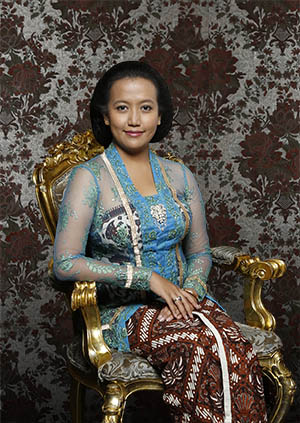
A kebaya is an upper garment traditionally worn by women in Southeast Asia, notably in Brunei, Indonesia, Malaysia, Singapore, and Southern Thailand. It is also worn in parts of southern Philippines

Punjabi wedding traditions are a strong reflection of Punjabi culture with ritual, song, dance, food, and dress that have evolved over centuries.
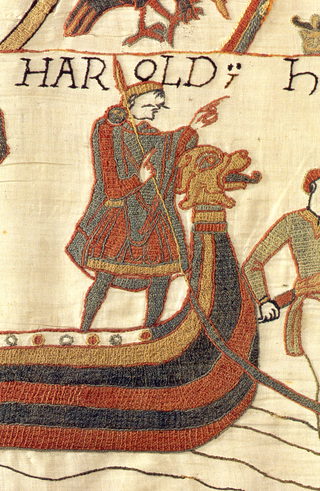
Anglo-Saxon dress refers to the clothing and accessories worn by the Anglo-Saxons from the middle of the fifth century to the eleventh century. Archaeological finds in Anglo-Saxon cemeteries have provided the best source of information on Anglo-Saxon costume. It is possible to reconstruct Anglo-Saxon dress using archaeological evidence combined with Anglo-Saxon and European art, writing and literature of the period. Archaeological finds have both supported and contradicted the characteristic Anglo-Saxon costume as illustrated and described by these contemporary sources.
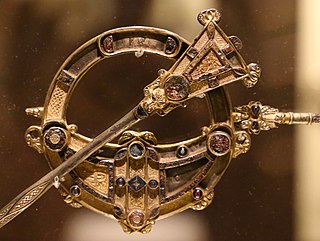
The Celtic brooch, more properly called the penannular brooch, and its closely related type, the pseudo-penannular brooch, are types of brooch clothes fasteners, often rather large; penannular means formed as an incomplete ring. They are especially associated with the beginning of the Early Medieval period in Ireland and Britain, although they are found in other times and places—for example, forming part of traditional female dress in areas in modern North Africa.

The national costume of Indonesia is the national attire that represents the Republic of Indonesia. It is derived from Indonesian culture and Indonesian traditional textile traditions. Today the most widely recognized Indonesian national attires include batik and kebaya, although originally those attires mainly belong within the island of Java and Bali, most prominently within Javanese, Sundanese and Balinese culture. Since Java has been the political and population center of Indonesia, folk attire from the island has become elevated into national status.

The term mutisalah refers to heirloom beads in the Lesser Sunda Islands of Timor, Flores, Sumba and Savu. Mutisalah are also found in the Philippines and Borneo. Mutisalah were originally Indo-Pacific beads of orange and orange-red color. The earliest of these beads came from Southern India and have been dated as early as 200 BC. Their manufacture spread to other centers.
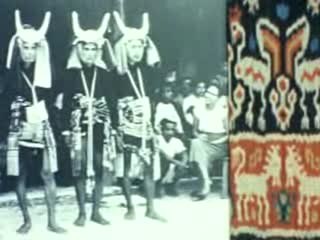
The textiles of Sumba, an island in eastern Indonesia, represent the means by which the present generation passes on its messages to future generations. Sumbanese textiles are deeply personal; they follow a distinct systematic form but also show the individuality of the weavers and the villages where they are produced. Internationally, Sumbanese textiles are collected as examples of textile designs of the highest quality and are found in major museums around the world, as well as in the homes of collectors.

Anakalang is a village area (desa) and a small kingdom in the western part of Sumba island, in eastern Indonesia. It is noted for numerous megalithic tombs and its quadrangular adzes.

This early twentieth century woman's ceremonial skirt from the Indonesian island of Sumba is part of the textiles collection of the Indianapolis Museum of Art, which is in Indianapolis, Indiana. Also known as a lau hada, the skirt would have been a nuptial gift for a woman of great social standing, since it is made of imported, machine-woven cotton cloth, glass trade beads, and nassa shells, which were once used as currency.

The Sumba people are an ethnic group inhabiting Sumba Island in Indonesia, which is divided by four regencies, namely the Southwest Sumba Regency, West Sumba Regency, Central Sumba Regency, and the East Sumba Regency. They refer to themselves as Tau Humba. The Sumbese have been able to retain much of their culture despite foreign influences that arrived long ago on the Lesser Sunda Islands.

Mughal clothing refers to clothing worn by the Mughals in the 16th, 17th and 18th centuries throughout the extent of their empire. Much of them were already being used in the past centuries before their arrival in Indian subcontinent. It was characterized by luxurious styles and was made with muslin, silk, velvet and brocade. Elaborate patterns including dots, checks, and waves were used with colors from various dyes including cochineal, sulfate of iron, sulfate of copper, and sulfate of antimony were used.
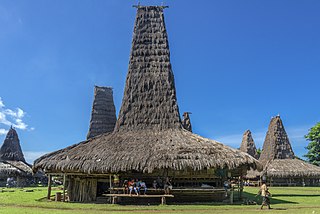
The Sumbanese traditional house refers to the traditional vernacular house of the Sumba people from the island of Sumba, Lesser Sunda Islands, Indonesia. A Sumbanese house is characterized by a high-pitched central peak on its roof and a strong connection with the spirits, or marapu.
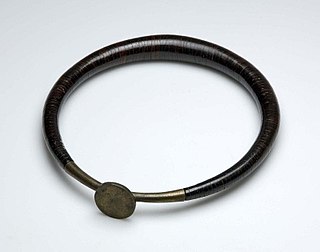
Kalabubu, sometimes spelled Kala bubu, is a torc worn by warriors of the people of South Nias of North Sumatra, Indonesia. Kalabubu symbolizes triumph in warfare and heroism. Wearing a kalabubu was believed to protect the wearer from harm. Kalabubu is popularly known as the "headhunter's necklace"; historically only those who already decapitated the head of the enemy tribes are allowed to wear the kalabubu.
Taiganja are precious metal ornaments found in Central Sulawesi, Indonesia, especially in the Sigi Regency. They are used as a kind of jewelry to enhance the status of the wearer, or as protective amulets. The core shape of the taiganja, reminiscent of the female genitalia, is an endemic shape that has been found throughout the Southeast Asian region.
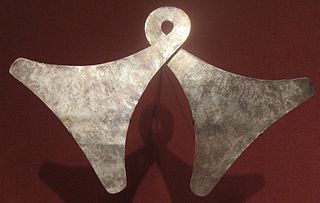
Marangga are precious metal valuable of the Sumba people of Sumba Island, Indonesia. They are found in the megalithic culture of the western Sumba people, e.g. the Anakalang society. They have the shape of a twisted metal sheet with a broadened end that has the shape of an axe. The marangga of Sumba is worn hung to the neck as a pendant, forming a kind of chest plate.
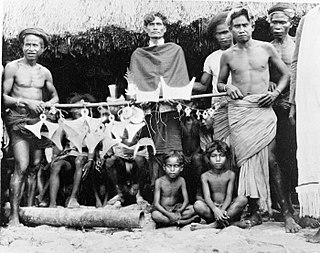
Madaka, also written as mendaka, is a type of precious metal valuable to the Sumba people of Sumba Island, Indonesia. It is found in the megalithic culture of the western Sumba people, e.g. the tribe of Anakalang. Of all precious metal valuable to Sumba people, the madaka is considered to be the most sacred type of gold heirloom.

Timorese wedding traditions apply to marriages on the island of Timor, which is divided between Indonesia and East Timor. The wedding traditions are still followed in about half of all marriages in East Timor. Ever since colonial times, there has been heated debate about the value of these traditions and the role of women in them.
Loli, historically also known as Lauli, is a district (kecamatan) of West Sumba Regency, East Nusa Tenggara Province, Indonesia. The district consists of nine rural villages (desa) and five urban villages (kelurahan) and has its seat in Doka Kaka village. The district has a total area of 132.36 square kilometres (51.10 sq mi) and had a population of 41,610 as at mid 2022. The most populous village in the district is Soba Wawi, which had a population of 6,092 people in 2020, while the most densely populated village was Wee Karou with a density of 731.67 people per square kilometre. The district is the site of Gollu Potto, a statue of Jesus which is one of the main landmarks of the regency itself and the largest in the island of Sumba.



















